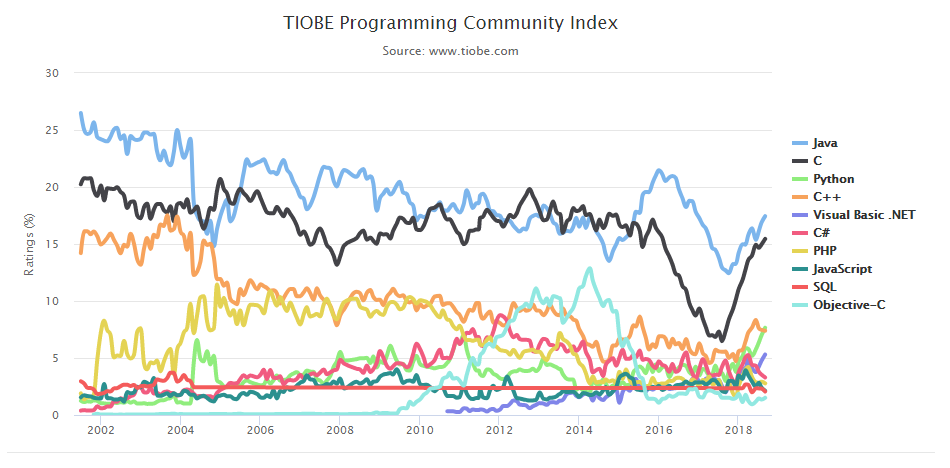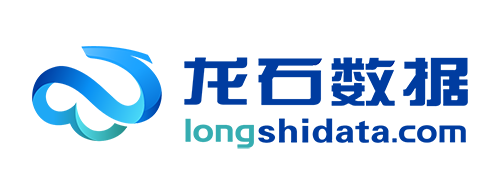TIOBE Index for September 2018
September Headline: Python enters the TIOBE index top 3 for the first time
Python has entered the TIOBE index top 3 for the first time in its history. This really took a long time. At the beginning of the 1990s it entered the chart. Then it took another 10 years before it reached the TIOBE index top 10 for the first time. After that it slowly but surely approached the top 5 and eventually the top 3. Python is becoming increasingly ubiquitous. It is already the first choice at universities (for all kinds of subjects for which programming is demanded) and is now also conquering the industrial world. Python's selling points are easy to learn, easy to install and easy to deploy. Other interesting moves this month are: Rust jumps from #36 to #31, Groovy from #44 to #34 and Julia from #50 to #39.
IMPORTANT NOTE. SQL has been added again to the TIOBE index since February 2018. The reason for this is that SQL appears to be Turing complete. As a consequence, there is no recent history for the language and thus it might seem that the SQL language is rising very fast. This is not the case.
The TIOBE Programming Community index is an indicator of the popularity of programming languages. The index is updated once a month. The ratings are based on the number of skilled engineers world-wide, courses and third party vendors. Popular search engines such as Google, Bing, Yahoo!, Wikipedia, Amazon, YouTube and Baidu are used to calculate the ratings. It is important to note that the TIOBE index is not about the best programming language or the language in which most lines of code have been written.
The index can be used to check whether your programming skills are still up to date or to make a strategic decision about what programming language should be adopted when starting to build a new software system. The definition of the TIOBE index can be found here.
| Sep 2018 | Sep 2017 | Change | Programming Language | Ratings | Change |
|---|---|---|---|---|---|
| 1 | 1 | Java | 17.436% | +4.75% | |
| 2 | 2 | C | 15.447% | +8.06% | |
| 3 | 5 |  |
Python | 7.653% | +4.67% |
| 4 | 3 |  |
C++ | 7.394% | +1.83% |
| 5 | 8 |  |
Visual Basic .NET | 5.308% | +3.33% |
| 6 | 4 |  |
C# | 3.295% | -1.48% |
| 7 | 6 |  |
PHP | 2.775% | +0.57% |
| 8 | 7 |  |
JavaScript | 2.131% | +0.11% |
| 9 | - |  |
SQL | 2.062% | +2.06% |
| 10 | 18 |  |
Objective-C | 1.509% | +0.00% |
| 11 | 12 |  |
Delphi/Object Pascal | 1.292% | -0.49% |
| 12 | 10 |  |
Ruby | 1.291% | -0.64% |
| 13 | 16 |  |
MATLAB | 1.276% | -0.35% |
| 14 | 15 |  |
Assembly language | 1.232% | -0.41% |
| 15 | 13 |  |
Swift | 1.223% | -0.54% |
| 16 | 17 |  |
Go | 1.081% | -0.49% |
| 17 | 9 |  |
Perl | 1.073% | -0.88% |
| 18 | 11 |  |
R | 1.016% | -0.80% |
| 19 | 19 | PL/SQL | 0.850% | -0.63% | |
| 20 | 14 |  |
Visual Basic | 0.682% | -1.07% |

Other programming languages
The complete top 50 of programming languages is listed below. This overview is published unofficially, because it could be the case that we missed a language. If you have the impression there is a programming language lacking, please notify us at tpci@tiobe.com. Please also check the overview of all programming languages that we monitor.
| Position | Programming Language | Ratings |
|---|---|---|
| 21 | SAS | 0.645% |
| 22 | Dart | 0.585% |
| 23 | D | 0.564% |
| 24 | Scratch | 0.539% |
| 25 | F# | 0.498% |
| 26 | COBOL | 0.492% |
| 27 | Scala | 0.471% |
| 28 | ABAP | 0.433% |
| 29 | Fortran | 0.415% |
| 30 | Lua | 0.405% |
| 31 | Rust | 0.396% |
| 32 | Transact-SQL | 0.316% |
| 33 | Lisp | 0.308% |
| 34 | Groovy | 0.298% |
| 35 | LabVIEW | 0.269% |
| 36 | Prolog | 0.265% |
| 37 | Ada | 0.255% |
| 38 | Logo | 0.251% |
| 39 | Julia | 0.242% |
| 40 | Haskell | 0.218% |
| 41 | Apex | 0.214% |
| 42 | Kotlin | 0.213% |
| 43 | Bash | 0.192% |
| 44 | Ladder Logic | 0.190% |
| 45 | Alice | 0.179% |
| 46 | Tcl | 0.172% |
| 47 | Clojure | 0.152% |
| 48 | PostScript | 0.152% |
| 49 | Scheme | 0.150% |
| 50 | Awk | 0.147% |
The Next 50 Programming Languages
The following list of languages denotes #51 to #100. Since the differences are relatively small, the programming languages are only listed (in alphabetical order).
- 4th Dimension/4D, ABC, ActionScript, bc, Bourne shell, C shell, CFML, CL (OS/400), CoffeeScript, Common Lisp, Crystal, cT, Elixir, Elm, Emacs Lisp, Erlang, Forth, Hack, Icon, Inform, Io, J, Korn shell, LiveCode, Maple, Mercury, ML, Modula-2, Monkey, MQL4, MS-DOS batch, MUMPS, NATURAL, OCaml, OpenCL, OpenEdge ABL, Oz, PL/I, PowerShell, Q, Racket, Ring, RPG, S, Snap!, SPARK, SPSS, Tex, TypeScript, VHDL
This Month's Changes in the Index
This month the following changes have been made to the definition of the index:
- There are lots of mails that still need to be processed. As soon as there is more time available your mail will be answered. Please be patient.
Very Long Term History
To see the bigger picture, please find below the positions of the top 10 programming languages of many years back. Please note that these are averagepositions for a period of 12 months.
| Programming Language | 2018 | 2013 | 2008 | 2003 | 1998 | 1993 | 1988 |
|---|---|---|---|---|---|---|---|
| Java | 1 | 2 | 1 | 1 | 16 | - | - |
| C | 2 | 1 | 2 | 2 | 1 | 1 | 1 |
| C++ | 3 | 4 | 3 | 3 | 2 | 2 | 4 |
| Python | 4 | 7 | 6 | 11 | 23 | 17 | - |
| C# | 5 | 5 | 7 | 8 | - | - | - |
| Visual Basic .NET | 6 | 11 | - | - | - | - | - |
| JavaScript | 7 | 9 | 8 | 7 | 20 | - | - |
| PHP | 8 | 6 | 4 | 5 | - | - | - |
| Ruby | 9 | 10 | 9 | 18 | - | - | - |
| Delphi/Object Pascal | 10 | 13 | 10 | 9 | - | - | - |
| Perl | 14 | 8 | 5 | 4 | 3 | 11 | - |
| Objective-C | 15 | 3 | 40 | 56 | - | - | - |
| Ada | 29 | 19 | 18 | 15 | 13 | 5 | 3 |
| Fortran | 30 | 25 | 22 | 12 | 5 | 3 | 15 |
| Lisp | 31 | 12 | 16 | 13 | 7 | 6 | 2 |
Programming Language Hall of Fame
The hall of fame listing all "Programming Language of the Year" award winners is shown below. The award is given to the programming language that has the highest rise in ratings in a year.
| Year | Winner |
|---|---|
| 2017 |  C C |
| 2016 |  Go Go |
| 2015 |  Java Java |
| 2014 |  JavaScript JavaScript |
| 2013 |  Transact-SQL Transact-SQL |
| 2012 |  Objective-C Objective-C |
| 2011 |  Objective-C Objective-C |
| 2010 |  Python Python |
| 2009 |  Go Go |
| 2008 |  C C |
| 2007 |  Python Python |
| 2006 |  Ruby Ruby |
| 2005 |  Java Java |
| 2004 |  PHP PHP |
| 2003 |  C++ C++ |
文章来源于:https://www.tiobe.com/tiobe-index/

